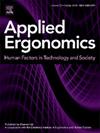以人为中心的虚拟照明:虚拟环境中色温和日光模拟的影响
IF 3.4
2区 工程技术
Q2 ENGINEERING, INDUSTRIAL
引用次数: 0
摘要
随着虚拟环境和虚拟世界平台改变人类互动,了解照明如何影响数字空间中的感知和行为至关重要。本研究调查了相关色温(CCT)和虚拟日光在两个互补实验中对虚拟环境的人类评估的影响:一个在不受控制的现实世界环境中进行,另一个在受控的实验室环境中进行。基于以人为中心的照明(HCL)原则,我们提出了一个以人为中心的虚拟照明(HCVL)框架,以优化沉浸式数字空间中的用户体验。在实验1中,参与者使用Flynn等人的语义差异量表评估了12个不同照明条件下的虚拟展台和会议空间效果图。现实世界环境优先考虑生态效度,参与者使用个人设备(例如,具有不同的亮度和分辨率),代表不同的人口统计学(22个国家,年龄在20-58岁)。实验2在受控的实验室条件下复制了该设计,使用标准化监测器和同质参与者组(18-26岁的德国本科生)。两个实验都评估了对温暖、亮度、空间和偏好的感知,并通过统计分析比较了温暖与凉爽的CCT以及日光与室内照明效果。主要发现表明,CCT对感知亮度的影响很大,对刺激和空间的影响中等,与物理照明研究一致。虚拟日光引发了强烈的偏好,被认为更明亮、更私密、更美观,反映了人类对日光的先天偏见。至关重要的是,实验室结果证实了现实世界的发现,但具有更大的一致性,强调了设备可变性和人口多样性对现实世界环境结果的影响。本研究有三个主要贡献:(1)HCVL原理的实证验证,表明CCT和日光的影响超越了环境形态(物理vs虚拟);(2)虚拟照明研究中平衡生态有效性和实验控制的方法框架;(3)对虚拟空间设计师的实用见解,强调用户期望(例如,“概念照明”)和自适应日光模拟的整合。这些结果弥合了物理和虚拟照明研究之间的差距,为创建身临其境的、以健康为导向的数字空间提供了可操作的指导方针。未来的工作应该探索HCVL的文化和环境调节因素,以支持包容性的虚拟空间设计。本文章由计算机程序翻译,如有差异,请以英文原文为准。
Human-centric virtual lighting: Effects of color temperature and daylight simulation in virtual environments
As virtual environments and metaverse platforms transform human interaction, understanding how lighting influences perception and behavior in digital spaces is critical. This study investigates the effects of correlated color temperature (CCT) and virtual daylight on human evaluations of virtual environments across two complementary experiments: one conducted in an uncontrolled real-world setting and the other in a controlled laboratory environment. Building on principles of human-centric lighting (HCL), we propose a framework for human-centric virtual lighting (HCVL) to optimize user experience in immersive digital spaces. In Experiment 1, participants evaluated 12 renderings of virtual exhibition stands and meeting spaces under varied lighting conditions, using Flynn et al.’s semantic differential scale. The real-world setting prioritized ecological validity, with participants using personal devices (with, for example, heterogeneous brightness and resolution) and representing diverse demographics (22 nationalities, ages 20–58). Experiment 2 replicated the design in a controlled laboratory condition, utilizing standardized monitors, and a homogeneous participant group (German undergraduate students, ages 18–26). Both experiments assessed perceptions of warmth, brightness, spaciousness, and preference, with statistical analyses comparing warm vs. cool CCT and daylight vs. room lighting effects. Key findings revealed large effects of CCT on perceived brightness and medium effects on stimulation and spaciousness, aligning with physical lighting research. Virtual daylight elicited robust preferences, rated as brighter, more private and aesthetically appealing, reflecting innate human biases toward daylight. Crucially, the laboratory results confirmed the real-world findings but with greater consistency, underscoring the impact of device variability and demographic diversity on the result from real-world setting. This study makes three primary contributions: (1) Empirical validation of HCVL principles, demonstrating that the effects of CCT and daylight transcend environmental modality (physical vs. virtual); (2) A methodological framework for balancing ecological validity and experimental control in virtual lighting research; (3) Practical insights for virtual space designers, emphasizing the integration of user expectations (e.g., “conceptual lighting”) and adaptive daylight simulations. These results bridge the gap between physical and virtual lighting research, offering actionable guidelines for creating immersive, well-being-oriented digital spaces. Future work should explore cultural and ambient moderators of HCVL to support inclusive virtual spaces design.
求助全文
通过发布文献求助,成功后即可免费获取论文全文。
去求助
来源期刊

Applied Ergonomics
工程技术-工程:工业
CiteScore
7.50
自引率
9.40%
发文量
248
审稿时长
53 days
期刊介绍:
Applied Ergonomics is aimed at ergonomists and all those interested in applying ergonomics/human factors in the design, planning and management of technical and social systems at work or leisure. Readership is truly international with subscribers in over 50 countries. Professionals for whom Applied Ergonomics is of interest include: ergonomists, designers, industrial engineers, health and safety specialists, systems engineers, design engineers, organizational psychologists, occupational health specialists and human-computer interaction specialists.
 求助内容:
求助内容: 应助结果提醒方式:
应助结果提醒方式:


